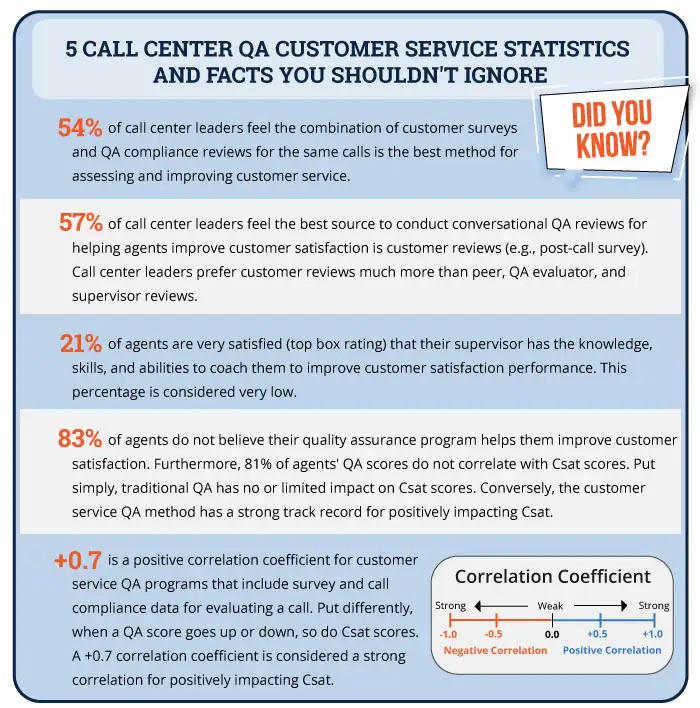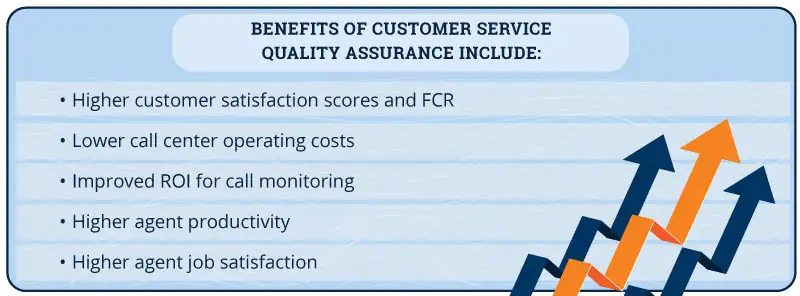As call centers strive to exceed customer expectations, it becomes imperative to establish and uphold the highest standards of customer service. This blog delves into the top five customer service best practices that not only elevate the quality of interactions but also contribute to the overall success of call centers.
1. Customer Service Quality Assurance (CQA)
CQA ranks as the first and foremost best practice for call centers to achieve excellent customer service. Implementing an effective CQA program gives a call center a bird's eye view of its strengths and weaknesses by combining both the company's and customers' perspectives.
Customer Service Quality Assurance (CQA) is considered a holistic view of customer service because it represents both the customer's and the company's perspective by combining customer survey, QA, and call compliance metrics. CQA uses VoC data to evaluate call quality to enhance, rather than replace, the established call monitoring process. The customer survey information alone cannot replace the entire CQA process because the customer cannot judge some metrics such as call compliance and information accuracy.
The internal evaluation determines whether the organizational requirements are met and is evaluated by supervisors, the call center monitoring team, or AI processes. Moreover, the organization focuses on metrics that the customer cannot assess, like caller identification, screen navigation, adherence to call compliance, and various facets of call handling, including information accuracy, utilization of knowledge management tools, note-taking, and wrap-up procedures.
The external evaluation determines the satisfaction of customer needs and is evaluated by the customers themselves. Additionally, customers focus on metrics that directly involve their judgment, including resolved inquiries or issues, Csat, and QA metrics, such as CX journey and empathy. These customer-centric metrics leverage post-call phone or email surveys, analytical tools, and AI to calculate the mySQM™ QA Score.
By using this holistic approach, companies better understand areas where they excel and areas where they could improve. Implementing CQA in the call center holds the agents, supervisors, and managers accountable for delivering better customer service. It is a great way to identify coaching and improvement opportunities by highlighting the performance gaps.
If Customer Service QA is appropriately implemented, a call center can expect up to a 10% improvement in FCR. SQM research shows for "every 1% improvement in FCR, there is a 1% improvement in customer satisfaction." Therefore, FCR is a driving factor of high-quality customer service and high customer satisfaction scores, so a 10% improvement in FCR is a drastic improvement for the entire call center.

mySQM™ QA Score is an excellent example of a CQA program because of its effectiveness in helping call centers improve CX and customer service. For the mySQM™ QA Score, 85% of points customer-focused and 15% of points organization-focused. The mySQM™ QA Score uses AI technologies to capture, analyze, and report CQA data.
The mySQM™ QA Score is based on 10 Customer Service QA metrics that are weighted for importance for impacting customer service delivery. Due to the standardized measurement approach, the mySQM™ QA Score can be tracked and benchmarked at the agent to the call center level within a company or against other companies. To our knowledge, SQM is the only company that offers a benchmarking QA service.

Request a mySQM™ Customer Service QA Demo Video
Learn about SQM's agent… CSAT prediction model, which is based on standardized metrics, AI, and regression analysis to predict customer satisfaction derived from a QA evaluation. Our CSAT prediction model provides a high statistical correlation, translating to a 95% success rate in predicting agent CSAT in most cases.

2. Performance Management
Implementing a performance management system is another best practice for achieving great customer service in a call center. This system will optimize agent efficiency and effectiveness, allowing call centers to deliver high-quality customer service in a cost-effective manner.
Performance management involves setting key performance indicators (KPIs) and metrics, collecting and analyzing data, providing feedback and coaching to agents, and implementing strategies to improve customer service, first call resolution (FCR), and overall call center performance.
SQM has found that companies using a Call Center Performance Management system incorporating post-call customer surveys have improved their FCR and Csat performance by as much as 10% for each metric. Moreover, FCR and Csat improvement can occur in 30 days or less, even in large call centers.
Most call centers use a performance management system technology such as mySQM™ QA software to help them monitor and evaluate agent performance. Also, agents and managers should be able to review their performance in real-time using a call center dashboard.

Performance management includes:
- Goal setting: Establishing goals and objectives aligned with the call center's overall mission. These goals should be clearly defined and measurable.
- Identifying and tracking performance metrics and KPIs: Typical agent performance metrics and KPIs include first call resolution (FCR), call center Csat, agent Csat, CQA score, and agent productivity.
- Data collection and analysis: Collect pertinent data from various sources, including call recordings, customer surveys, and system reports. The analysis of this data yields valuable insights into agent performance, customer behavior, and operational trends.
- Monitor and evaluate agent performance: Assess agent performance through call monitoring, quality assurance evaluations, customer surveys, and performance reviews.
- Feedback and coaching: Providing constructive feedback helps identify improvement areas, reinforce best practices, and enhance agent skills and knowledge.
3. Real-time Recognition
Call center agents are the voice of the company, and in order to keep your best agents satisfied and motivated, their hard work needs to be recognized and appreciated. SQM research shows that agents recognized for delivering high CX are motivated to go the extra mile to resolve calls. In other words, great customer service is positively correlated with agent recognition.
Recognition programs address the intrinsic need for acknowledgment and reward, fostering a positive working environment. By tying recognition to specific behaviors, such as achieving high Csat scores or resolving customer issues effectively, agents are incentivized to perform at their best consistently.
Real-time recognition is the most effective type of recognition program due to its immediacy. Agents can be rewarded almost instantly after their positive CX behavior. These rewards can come in the form of points, prizes, or financial compensation. This instant gratification is a powerful motivator, reinforcing positive behaviors and creating a continuous improvement cycle.
SQM's employee real-time financial recognition program is a prime example of an effective software tool for motivating agents to improve first contact resolution and customer service while simultaneously lowering operating costs. SQM's financial recognition program awards points based on post-call surveys, QA, and internal agent performance data captured in mySQM™ Customer Service QA software.
For example, a post-call survey is completed on an agent at 11:00 AM, and at 11:05 AM of the same day, receives $20 on their SQM debit card as a reward for providing outstanding customer service. This is the best way of showing acknowledgment and recognition in real-time. Agents earn these rewards based on their performance in post-call surveys, quality assurance evaluations, and internal data metrics.

These points that agents earn can then be converted to dollars and redeemed using an SQM debit card and used at most retailers. Because of the real-time aspect of this program, agents are provided with an immediate sense of accomplishment following a positive interaction. This creates a positive feedback loop, encouraging them to deliver outstanding customer service consistently.
4. Benchmarking
Benchmarking is important because it shows where your call center or team stands relative to other leading North American call centers. Benchmarking sets the standard for what type of customer service your call center must deliver to perform at a world-class level.
Benchmarking puts a call center's metrics and KPIs into perspective by providing an objective means of evaluating their performance against industry standards and peers. Through benchmarking, call centers can identify their strengths and weaknesses compared to industry leaders, enabling them to set realistic performance targets.
This process promotes a continuous improvement cycle, encouraging call centers to adopt industry best practices and innovative strategies to stay ahead of the curve. By leveraging benchmarking data, call centers gain valuable insights into key performance indicators, service levels, and customer satisfaction metrics, facilitating informed decision-making and strategic planning.
Moreover, benchmarking fosters a culture of accountability within call center teams. When employees understand how their performance compares to industry benchmarks, they are motivated to achieve and surpass those standards. This not only boosts individual morale but also contributes to a collective effort to elevate the overall quality of customer service.
For example, an agent who ranks in 3rd place among their team of other call center agents would feel motivated and determined to improve and move up to 2nd, and eventually, 1st place. Benchmarking performance is a great way to boost motivation by adding some competition into the mix.
The call center industry views SQM as the thought leader and gold standard for measuring, benchmarking, and improving Csat and FCR. SQM determines your call center's current performance for KPIs such as FCR, Csat, NPS, and OCR and compares your performance to call centers within your industry and across all industries, as well as with world-class Csat-performing call centers.

5. FCR Measurement
As mentioned above, SQM research shows that for every 1% improvement in FCR, there is a 1% improvement in customer service Csat. Additionally, for every 1% improvement in FCR, there is a 1% to 5% improvement in employee satisfaction. And, as the saying goes, happy stuff equals happy customers.
First Call Resolution (FCR) is a metric that measures a call center's performance for resolving customer interactions on the first call or contact, eliminating the need for follow-up contacts. Ideally, achieving FCR means no other calls or contacts are necessary to follow up after the initial call or contact from a customer journey perspective.
There are multiple ways to measure FCR, both externally and internally. External measurement is considered the most accurate way to measure and benchmark FCR because it is based on the customer’s opinion which, at the end of the day, is what matters most. Methods such as VoC or post-call surveys are used for external measurement of FCR. The post-call surveys use standardized questions and measurement methodology to facilitate benchmarking FCR against other call centers.
Measuring FCR allows your organization to gain tremendous insights into how customers view your call center's performance for efficiency and effectiveness metrics. FCR performance is highly correlated with operating efficiency and customer service effectiveness. Therefore, when FCR rates are high or low, so are your operating costs and quality of customer service.
Below are six benefits of measuring and improving FCR:

Measuring first call resolution can be difficult. SQM's QA software facilitates the process of measuring FCR and calculates an accurate FCR rate. SQM's QA software can measure the FCR rate using various calculation methods. For example, SQM's Customer Service QA software measures FCR using internal (e.g., quality monitoring/QA) and external (e.g., post-call phone surveys) methods to calculate the FCR rate.
